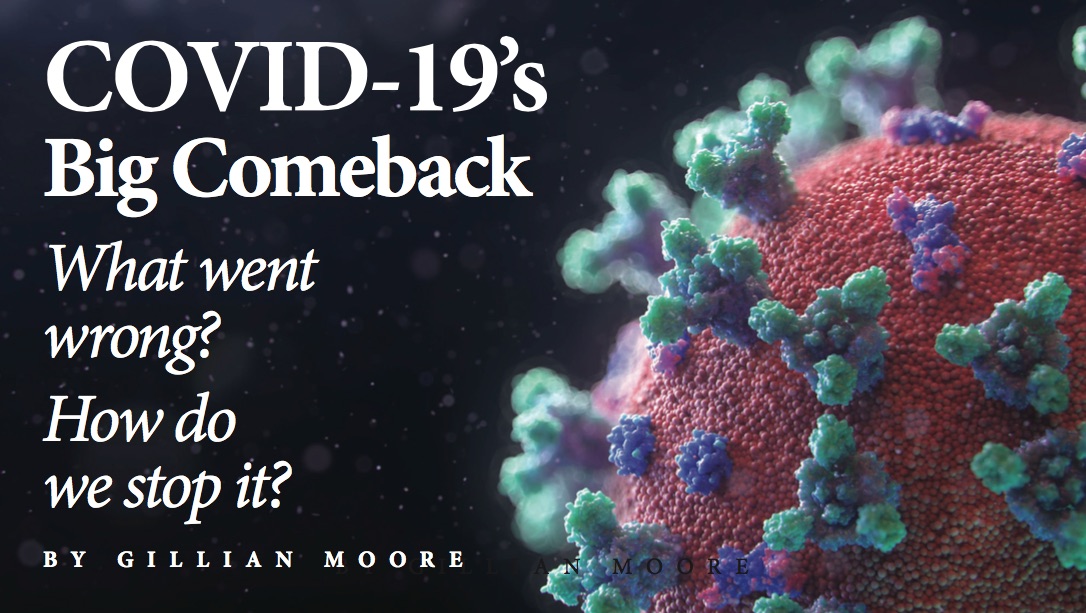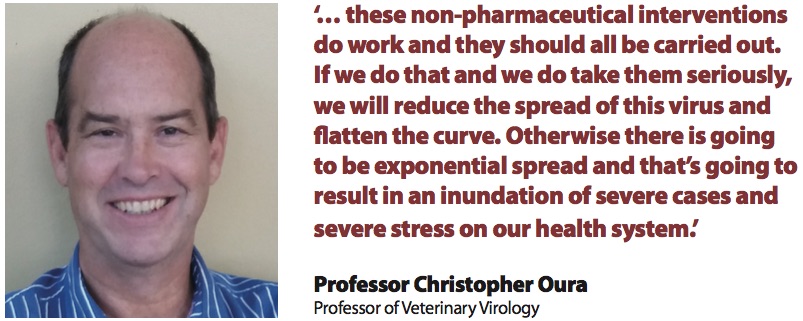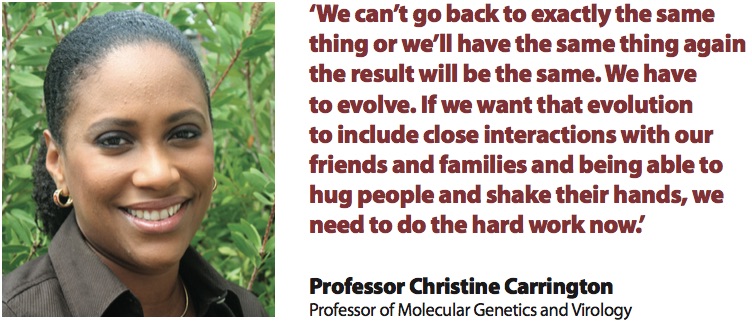
When the paradigm-shifting COVID-19 first came to T&T, the nation did a commendable job of controlling its spread. The University of the West Indies was at the heart of the effort, committing personnel, research, facilities and expertise. The University is now assisting with World Health Organisation (WHO) drug trials; UWI nurses were recruited to help with contact tracing of infected persons; and, at the behest of the Ministry of Health, the campus’ halls of residence, Canada and Freedom Halls, are being used as step-down facilities for COVID-19 patients. In addition, UWI staff have been providing technical support for diagnostic testing that is being done at a UWI lab that was loaned to the Health Ministry.
But the last several weeks have seen a surge in cases, sparking concern that we squandered our early success and that our health services might be overwhelmed by an inundation of infections.
What happened?
“This is the six-million-dollar question,” said Professor Christopher Oura, who a Professor of Veterinary Virology at UWI’s Faculty of Medical Sciences at Mt Hope. Speaking from Bristol, UK, from where he is currently conducting his UWI classes online, he said: “My opinion is that for those 80-odd days when everything was quiet, we’d got rid of the virus completely. What then probably happened was that the virus got into the country, probably through a person from Venezuela where the virus is circulating out of control.”

Professor Oura added, “It then circulated in a hidden, silent way among that population and among the people they were interacting with in Trinidad. A lot of people are asymptomatic. Or cases are mild. It showed itself when we got a positive test, but by that time it had already spread. Now we’re playing catch-up, trying to stop it through all the methods we’ve been told about by the Ministry of Health.”
Professor of Molecular Genetics and Virology Dr Christine Carrington likened the spike in COVID-19 cases to a fire threatening to burn out of control: “We don’t know what the ‘match’ was, but our behaviour is the tinder. Regardless of how this recent wave started, it is the behaviour of Trinidadians that promoted its spread.”
However, she cited three possible sources: “it is most likely that it was imported via an undocumented immigrant, but it could also have been that someone like a healthcare worker who is in frequent close contact with quarantined returning residents became infected, or that it was circulating at very, very low levels all the time, although I think it would have come to light sooner if that was the case.”
In spite of the frightening scenario he described, Professor Oura is optimistic that lockdown measures can turn our situation around. “We know how this virus is spread: by relatively close contact, by droplet infection. So we know if people keep apart by two metres and wear masks, we’re going to significantly reduce the spread. We know if people stay at home when they’re sick, they’re not going to be out there spreading the virus. We know that if it gets onto surfaces, we can easily disinfect them, and we know if it gets on hands, it can easily be deactivated by washing hands.”
He concluded that “these non-pharmaceutical interventions do work and they should all be carried out.
If we do that and we do take them seriously, we will reduce the spread of this virus and flatten the curve. Otherwise there is going to be exponential spread and that’s going to result in an inundation of severe cases and severe stress on our health system.”
Like her colleague, Prof Carrington believes behaviour can also turn the situation around.“The most important thing is to wear a mask — properly — over your nose and mouth. Remember that someone being your friend does not mean you don’t have to wear a mask when you’re with them. People seem to think the virus is associated with people who are ‘other’ — it can’t be someone in my little circle of friends. We need to understand that the virus does not discriminate.”
She also sees the need for the society “to understand how science works, how their bodies work. We need better science education, better general knowledge and literacy in general, and an education system that encourages critical thinking”.

Both professors stressed that human beings’ relationship to the environment was a significant factor that made us vulnerable to COVID-19 and other animal- borne pathogens.
“There is always the risk of infections from animals crossing to humans,” Prof Carrington said, “but this is exacerbated by the way we live now: rapid global transportation, dense human populations, encroaching on forests, deforestation, rapid urbanisation. It sets up more frequent opportunities for animal viruses to enter the human population and then to spread rapidly and widely from person to person.”
She warned, “there will be future ‘matches’. We need to operate in a way that whatever happens, the sparks do not take hold and spread.”
Prof Oura agreed: “We have to learn from our mistakes. The way we are dealing with nature and our planet, there is an increased chance of new viruses jumping from animals to humans. There have been more new viruses appearing in the last 30 years than before and this is directly due to the way humans are abusing the planet that they live on. It is critical to understand that we only have one planet, so we need to take care of it – there is no planet B”.
He advocated for the adoption of a “One Health” approach, defined by “finding sustainable solutions to interconnected health problems involving people, animals, and the environment through partnerships and cooperation across sectors”.
Looking to the future, both experts are hopeful for a vaccine and both indicated that they would have no hesitation in being vaccinated.
“I would absolutely, definitely take the vaccine,” Prof Oura said, “once it’s gone through the relevant regulators and clinical trials, and is proven to be safe and at least partially effective. I would be first in the queue and have my kids take the vaccine as well.”
In her optimism however, Prof Carrington said adherence to the “new normal” would eventually bear fruit:
“People need to recognise that all the current are in an effort to get us back as close as possible to how we were before. But the way humans operated (before) is what facilitated disease emergence and pandemic spread in the first place.”
She added, “We can’t go back to exactly the same thing or the result will be the same. We have to evolve. If we want that evolution to include close interactions with our friends and families and being able to hug people and shake their hands, we need to do the hard work now.”